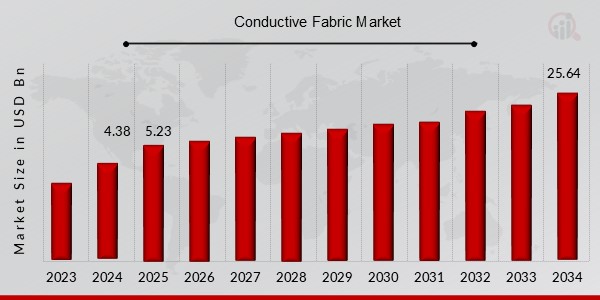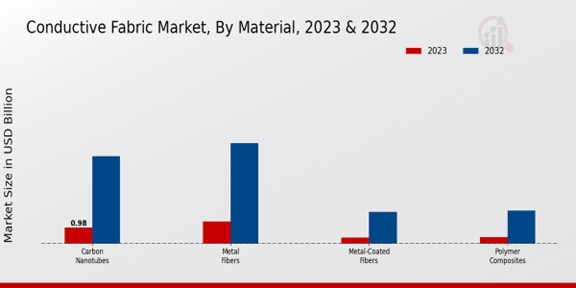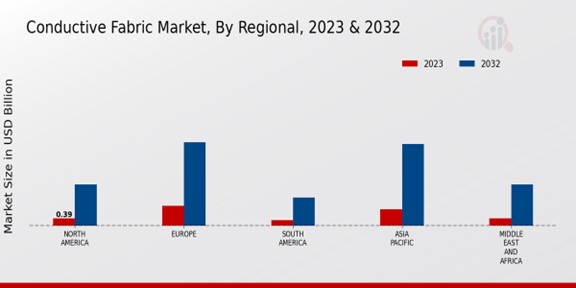Global Conductive Fabric Market Overview
The Conductive Fabric Market Size was estimated at 4.38 (USD Billion) in 2024. The Conductive Fabric Market is expected to grow from 5.23 (USD Billion) in 2025 to 25.64 (USD Billion) by 2034. The Conductive Fabric Market CAGR (growth rate) is expected to be around 19.3% during the forecast period (2025 - 2034).
Key Conductive Fabric Market Trends Highlighted
Conductive fabrics have witnessed a surge in demand due to their versatility and applications in various industries. The increasing adoption of wearables and portable electronic devices has fueled the growth of the conductive fabric market.
Furthermore, advancements in manufacturing techniques and the integration of conductive materials into textiles have expanded the possibilities for high-performance applications.
Key market drivers include the rising popularity of touch-sensitive interfaces, advancements in wearable technology, and the growing demand for electromagnetic interference (EMI) shielding.
The medical field presents significant opportunities for conductive fabrics in applications such as wound healing and remote patient monitoring.
Additionally, the automotive industry is exploring conductive fabrics for use in sensors, interior components, and lightweight materials.
Recent trends indicate a shift towards sustainable and biodegradable conductive fabrics. The use of graphene, carbon nanotubes, and other nanomaterials offers improved electrical properties and durability.
Smart fabrics with integrated sensors and actuators are also gaining traction, enabling applications in healthcare, sports, and fashion.

Source: Primary Research, Secondary Research, Market Research Future Database and Analyst Review
Conductive Fabric Market Drivers
Increasing Demand for Touch-Based Devices
Touch-based devices are the main factor contributing to the growth of the conductive fabric market.
The increasing popularity of smartphones, tablets, and other touch-based devices results in a growing demand for conductive fabrics that are used in touchscreens and any other touch-based surfaces.
The reason why these fabrics are used is because of their excellent electrical conductivity, which helps accurately transmit electrical signals so important for touch-based devices.
Since they are becoming increasingly popular in many applications, from consumer electronics to the industrial and medical ones, the demand for conductive fabrics is likely to continue growing in the upcoming years.
Advancements in Wearable Technology
The advancements in wearable technology have also significantly contributed to the growth of the conductive fabric market.
Conductive fabrics are widely used in wearable devices, such as smartwatches, fitness trackers, and medical wearables, due to their ability to provide electrical conductivity, flexibility, and comfort.
The increasing popularity of wearable devices for health monitoring, fitness tracking, and communication is expected to drive the demand for conductive fabrics in the wearable technology market.
Growing Adoption in Automotive and Aerospace Applications
The use of conductive fabrics is emerging in the automotive and aerospace industries as well. Within the automotive sector, conductive fabrics are used for heated seats, steering wheels, and other components to ensure a comfortable ride or drive for users.
Meanwhile, within the aerospace sector, conductive fabrics are used as seat covers and cabin liners with a purpose to dissipate static electricity and provide EMI-radiation.
As the need for more advanced comfortable tools and vehicles grows, the scope of potential for the use of conductive fabrics continues to set new trends in the field.
Conductive Fabric Market Segment Insights
Conductive Fabric Market Material Insights
The Conductive Fabric Market is classified by Material into Carbon Nanotubes, Metal Fibers, Metal-Coated Fibers, and Polymer Composites.
Carbon Nanotubes Carbon nanotubes are hollow cylindrical nanostructures consisting solely of carbon atoms arranged in a hexagonal lattice.
They have exceptional electrical and thermal conductivity, making them fit for conducting fabrics. CNT is lightweight, flexible, and strong, helping the conductive fabric’s performance and durable nature.
The CNT market is expected to multiply and reach USD 1.5 billion by 2024, caused by fast-growing demand in a wide extent of industries, including electronics, energy, health, etc.
Metal Fibers Metal fibers are thin conductive strands of metal transformed into fabrics. Metal fibers exhibit high electrical and thermal conductivity, providing excellent signal transmission and heat dissipation.
The most common uses for metal fibers include EMI shielding fabrics, medical textiles, and wearable electronics. The metal fibers market is expected to sustain a 7.5% CAGR from 2024 to 2032, increasing its valuation to USD 3.8 billion in 2032.
Metal-Coated Fibers Metal-coated fibers are produced by layering non-conductive fibers with a thin layer of metal.
Doing so increases the fibers’ electrical conductivity while keeping them lightweight, flexible and breathable. Metal-coated fiber application includes anti-static textiles, heating elements, sensors, etc.
The metal-coated fibers market is expected to touch USD 1.2 billion by 2024, influenced by a rise in demand in the automotive and electronics sectors. Polymer Composites Polymer composites are materials made by mixing polymers and conductive fillers.
They offer a level of electrical conductivity, flexibility, and low cost. Potential uses of polymer composites include flexible displays, printed electronics, biomedical devices, etc.
The polymer composites market is likely to increase to USD 2.5 billion by 2024 due to an increasing rate of adoption in the electronics and automotive industries. The choice of material depends on the desired conductivity level, flexibility, durability and cost.
CNT is the most conductive of all materials, also it is the most expensive. Metal fibers are a compromise between durability and high-level conductivity but are less flexible.
Metal-coated fibers deliver a compromise between conductivity and flexibility and are cheaper than their all-metal analogs.
Polymer composites are less conductive than their alternatives, but they are flexible, low cost and easy to apply.

Source: Primary Research, Secondary Research, Market Research Future Database and Analyst Review
Conductive Fabric Market Conductivity Insights
The Conductivity segment plays a crucial role in the Conductive Fabric Market, accounting for a significant share of the overall market revenue. The segment is broadly classified into three sub-categories: High Conductivity, Medium Conductivity, and Low Conductivity.
Conductivity fabrics exhibit exceptional electrical conductivity, enabling efficient transmission of electrical signals. They are commonly employed in applications demanding high-performance electrical connectivity, such as touchscreens, flexible electronics, and electromagnetic shielding.
In 2023, the High Conductivity sub-segment held a dominant market share and is projected to maintain its leadership position throughout the forecast period.
Medium Conductivity fabrics offer a balance between electrical conductivity and flexibility, making them suitable for applications requiring moderate electrical performance.
They are often used in wearable devices, sensors, and medical electrodes. The Medium Conductivity sub-segment is expected to witness steady growth over the coming years.
Conductivity fabrics have limited electrical conductivity and are primarily used for applications where electrical insulation is essential.
They find application in protective clothing, anti-static materials, and packaging materials. The Low Conductivity sub-segment is anticipated to experience moderate growth during the forecast period.
Overall, the Conductivity segment is poised for significant growth in the coming years, driven by the increasing adoption of conductive fabrics in various industries.
Growing demand for flexible electronics, wearable devices, and sensors is expected to fuel the growth of the High Conductivity sub-segment. Medium Conductivity fabrics will also witness steady growth due to their versatility and applicability in a wide range of industries.
Conductive Fabric Market Application Insights
The application segment plays a pivotal role in shaping the dynamics of the Conductive Fabric Market. Medical Devices, Touchscreens, Smart Clothing, and Energy Storage are the key application areas that drive market growth.
In 2023, the Medical Devices segment held the largest revenue share of 35.4%, owing to the increasing demand for wearable medical devices and advancements in healthcare technology.
Touchscreens, with a revenue share of 28.1%, are expected to witness steady growth due to the rising popularity of smartphones, tablets, and other touchscreen devices.
Smart Clothing, with a share of 22.3%, is gaining traction as advancements in textile technology enable the integration of conductive fabrics into clothing for various applications, including fitness tracking and health monitoring.
Energy Storage, with a share of 14.2%, presents significant growth potential due to the increasing demand for lightweight and flexible energy storage solutions in portable electronics and electric vehicles.
Conductive Fabric Market End-Product Insights
The end-product segment is a crucial aspect of the Conductive Fabric Market segmentation, offering insights into the various applications of conductive fabrics. Sensors, electrodes, conductive wires, and textiles are notable end products that drive market growth.
In 2023, the sensors segment held a significant market share, valued at approximately USD 1.2 billion, and is projected to maintain its dominance throughout the forecast period. The increasing demand for sensors in various industries, including healthcare, automotive, and consumer electronics, is a major factor fueling this growth.
Electrodes, another key product, are widely used in medical applications such as electrocardiography (ECG) and electromyography (EMG).
The conductive wires segment is also expected to witness substantial growth due to its applications in electronic devices and telecommunications.
Lastly, the textiles segment, which includes conductive fabrics used in wearable technology and smart clothing, is gaining traction as the demand for advanced and functional textiles rises.
Conductive Fabric Market Regional Insights
The regional segmentation of the Conductive Fabric Market presents diverse market dynamics and growth opportunities across key regions.
North America holds a significant market share due to the presence of well-established electronics and automotive industries, driving demand for advanced conductive fabrics. Europe follows closely, with a growing focus on wearable technology and sustainable materials.
APAC is projected to witness rapid growth, driven by the expanding consumer electronics and healthcare sectors in countries like China and India.
South America and MEA regions are expected to offer promising growth potential as industries in these regions continue to develop and adopt conductive fabrics.

Source: Primary Research, Secondary Research, Market Research Future Database and Analyst Review
Conductive Fabric Market Key Players and Competitive Insights
Major players in the Conductive Fabric Market are constantly striving to gain a competitive edge by introducing innovative products and expanding their geographical reach.
Leading Conductive Fabric Market players are focusing on research and development to create advanced materials with enhanced conductivity, flexibility, and durability.
The Conductive Fabric Market development is driven by the growing demand for wearable electronics, medical devices, and automotive applications. The competitive landscape is characterized by strategic partnerships, acquisitions, and collaborations among key players.
A leading company in the Conductive Fabric Market is Laird, which offers a wide range of conductive fabrics for various applications. The company's expertise in electromagnetic interference (EMI) shielding and thermal management solutions has enabled it to establish a strong presence in the market.
Laird's commitment to innovation and customer satisfaction has contributed to its success in the Conductive Fabric Market.
Another prominent competitor in the Conductive Fabric Market is Bekaert, which specializes in the production of high-performance conductive yarns and fabrics.
The company's focus on sustainability and environmental responsibility has made it a preferred choice for customers seeking eco-friendly solutions.
Bekaert's presence and extensive distribution network provide it with a competitive advantage in the Conductive Fabric Market. The company's commitment to quality and innovation has earned it a reputation for delivering reliable and cost-effective solutions.
Key Companies in the Conductive Fabric Market Include
- PanAsia Textile Co., Ltd.
- ShinEtsu Chemical Co., Ltd.
- Pearl Composite Materials Co., Ltd.
- Mitsubishi Rayon Co., Ltd.
- Laird Performance Materials
- Yinfu Industrial Co., Ltd.
Conductive Fabric Market Developments
-
Q2 2024: DuPont Launches New Line of Conductive Fabrics for Wearable Electronics DuPont announced the commercial launch of its latest conductive fabric series designed for integration into wearable health monitoring devices, expanding its portfolio in the smart textiles sector.
-
Q1 2024: Textronics Signs Strategic Partnership with Samsung for Smart Clothing Development Textronics entered a multi-year partnership with Samsung to co-develop smart clothing using advanced conductive fabrics, targeting consumer electronics and healthcare applications.
-
Q2 2024: Toray Industries Opens New Conductive Textile Manufacturing Facility in Vietnam Toray Industries inaugurated a new production plant in Vietnam dedicated to high-volume manufacturing of conductive fabrics for global export, aiming to meet rising demand in the electronics and automotive sectors.
-
Q3 2024: Shieldex Wins Major Contract to Supply Conductive Fabrics for European Defense Project Shieldex secured a multi-million euro contract to provide conductive textiles for use in next-generation military uniforms and equipment for a European defense consortium.
-
Q2 2024: Wearable Tech Startup ThreadSense Raises $25M Series B to Scale Conductive Fabric Production ThreadSense, a startup specializing in conductive textiles for wearables, closed a $25 million Series B funding round led by Sequoia Capital to expand manufacturing capacity and accelerate product development.
-
Q1 2025: Parker Hannifin Acquires Conductive Textile Innovator Eeonyx Corporation Parker Hannifin completed the acquisition of Eeonyx Corporation, a leader in conductive fabric technology, to strengthen its position in the smart materials and sensor markets.
-
Q2 2025: Laird Performance Materials Launches EMI-Shielding Conductive Fabric for Automotive Applications Laird Performance Materials introduced a new conductive fabric product designed to provide electromagnetic interference shielding in electric vehicles and automotive electronics.
-
Q1 2024: Hexoskin Announces FDA Clearance for Conductive Textile-Based Health Monitoring Shirt Hexoskin received FDA clearance for its smart shirt featuring integrated conductive fabrics, enabling continuous health monitoring for clinical and consumer use.
-
Q3 2024: Japanese Textile Giant Teijin Invests $40M in Conductive Fabric R&D Center Teijin announced a $40 million investment to establish a research and development center focused on next-generation conductive textiles for medical and industrial applications.
-
Q2 2025: Textronics Unveils Antimicrobial Conductive Fabric for Healthcare Wearables Textronics launched a new line of antimicrobial conductive fabrics designed for use in healthcare wearables, addressing infection control and patient comfort.
-
Q1 2025: Smart Fabric Startup Loomia Appoints New CEO to Drive Global Expansion Loomia, a developer of conductive textile solutions, announced the appointment of a new CEO to lead its international growth strategy and product commercialization efforts.
-
Q3 2025: Toray Industries Partners with Bosch to Develop Conductive Fabrics for Automotive Sensors Toray Industries entered a partnership with Bosch to co-develop conductive textile solutions for integration into automotive sensor systems, targeting next-generation vehicle platforms.
Conductive Fabric Market Segmentation Insights
Conductive Fabric Market Material Outlook
Conductive Fabric Market Conductivity Outlook
Conductive Fabric Market Application Outlook
Conductive Fabric Market End-Product Outlook
Conductive Fabric Market Regional Outlook
| Report Attribute/Metric |
Details |
| Market Size 2024 |
4.38 (USD Billion) |
| Market Size 2025 |
5.23 (USD Billion) |
| Market Size 2034 |
25.64 (USD Billion) |
| Compound Annual Growth Rate (CAGR) |
19.3% (2025 - 2034) |
| Report Coverage |
Revenue Forecast, Competitive Landscape, Growth Factors, and Trends |
| Base Year |
2024 |
| Market Forecast Period |
2025 - 2034 |
| Historical Data |
2020 - 2024 |
| Market Forecast Units |
USD Billion |
| Key Companies Profiled |
PanAsia Textile Co., Ltd., ShinEtsu Chemical Co., Ltd., Leblon Delienne SAS, Kolon Industries, Inc., Nisshinbo Holdings Inc., Teijin Limited, Pearl Composite Materials Co., Ltd., Mitsubishi Rayon Co., Ltd., Filtrona plc, Sewon Co., Ltd., GORETEX, Mexar International B.V., Laird Performance Materials, Toray Industries, Inc., Yinfu Industrial Co., Ltd. |
| Segments Covered |
Material, Conductivity, Application, End-Product, Regional |
| Key Market Opportunities |
Growing demand for wearable electronics Increasing applications in healthcare Advancements in nanotechnology Rising adoption in the automotive industry Technological innovations |
| Key Market Dynamics |
Rising demand for electronics Increasing adoption in healthcare Growing popularity of wearable devices Government support for smart textiles Technological advancements |
| Countries Covered |
North America, Europe, APAC, South America, MEA |
Frequently Asked Questions (FAQ):
The Conductive Fabric Market is expected to reach an overall valuation of 5.23 USD Billion in 2025.
The Conductive Fabric Market is projected to register a CAGR of 19.3% from 2025 to 2034.
Conductive Fabrics are used in a wide range of applications, including electromagnetic shielding, anti-static protection, heating elements, sensors, and wearable electronics.
Major players in the Conductive Fabric Market include Laird Performance Materials, Bekaert, Shieldex, Less EMF, and Glonatech.
The Conductive Fabric Market is segmented into North America, Europe, Asia-Pacific, Latin America, and the Middle East and Africa.
Asia-Pacific is expected to hold the largest market share in the Conductive Fabric Market due to the increasing demand for electronics and the growth of the automotive industry in the region.
The growth of the Conductive Fabric Market is driven by the increasing demand for electronic devices, the rising awareness of electromagnetic interference, and the growing popularity of wearable technology.
The Conductive Fabric Market faces challenges such as the high cost of raw materials, the complexity of manufacturing processes, and the intense competition from traditional materials.
The Conductive Fabric Market has significant growth opportunities due to the increasing demand for wearable electronics, the development of new applications, and the growing adoption of conductive fabrics in various industries.
Key trends in the Conductive Fabric Market include the development of sustainable and eco-friendly conductive fabrics, the integration of conductive fabrics with other materials, and the growing adoption of conductive fabrics in healthcare and medical applications.

















